How To Get Rid Of Ads On Google
What is the google.com redirect?
Google.com is the most popular search engine in the world, developed by the Google LLC multinational technology company, specializing in Internet-related services and products. However, users can encounter undesirable redirects to this legitimate search engine - due to rogue software, classified as browser hijackers, having infiltrated their device.
Products within this classification are considered to be PUAs (Potentially Unwanted Applications), as they usually infiltrate browsers/systems without user permission. While redirects to google.com may seem as something innocuous, especially if it is users' preferred search engine, browser hijackers are infamous for their data tracking abilities.
This software spies on users' browsing activity - in order to monetize sensitive data extracted from it. Therefore, it is strongly advised to remove browser hijackers and other unwanted applications immediately upon detection.
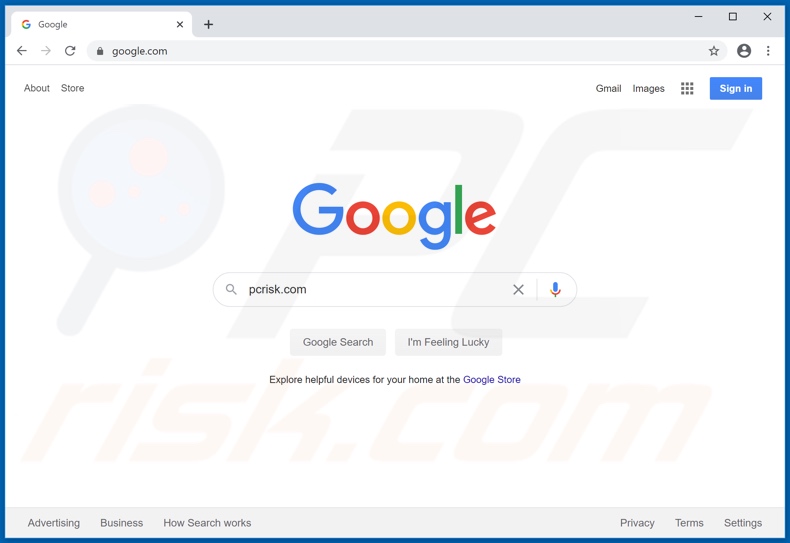
Browser hijackers target Google Chrome, Internet Explorer, Mozilla Firefox and other popular browsers with large user bases. This software operates by reassigning browsers' homepage, default search engine and new tab/window URLs.
Hence, with a browser hijacker installed, every new browser tab/window opened and every web search done via the URL bar - redirect to the address of the promoted search engine, such as Google, Yahoo, Bing, etc. However, browser hijacker typically do not redirect to genuine search engines straight away.
They tend to cause redirection chains, which begin with one or several fake search engines - and conclude with a legitimate one (e.g. google.com). Fake web searchers are rarely capable of generating search results, so they redirect to genuine search engines in order to further the impression of legitimacy; thereby, increasing the appearance of authenticity and usefulness of the browser hijacker.
This is more than a matter of search engine preference. The Google search engine is free and does not require interference of any third party programs to be used.
While such redirects may not truly inconvenience users, presence of browser hijackers is a serious privacy concern. Most browser hijackers can track data.
They monitor browsing activity and collect data of interest, e.g. URLs visited, pages viewed, search queries typed, IP addresses, geolocations and other details. The gathered data is highly likely to contain personally identifiable information.
Browser hijacker developers monetize this information by sharing it with and/or selling it to third parties (potentially, cyber criminals), seeking to likewise misuse it for profit. To summarize, browser hijackers can cause financial loss, severe privacy issues and even lead to identity theft.
Furthermore, it is impossible to recover a hijacked browser without removing the software affecting it. Browser hijackers can undo any changes users attempt to make to their browsers and/or restrict/deny access to the browser's settings outright.
To ensure device integrity and user safety, it is crucial to eliminate all suspicious applications and browser extensions/plug-ins without delay.
| Name | Google.com browser hijacker |
| Threat Type | Browser Hijacker, Redirect, Search Hijacker, Toolbar, Unwanted New Tab |
| Supposed Functionality | Browser hijackers promise enhanced search results, faster searches, improved web browsing experience |
| Affected Browser Settings | Homepage, new tab URL, default search engine |
| Symptoms | Manipulated Internet browser settings (homepage, default Internet search engine, new tab settings). Users are forced to visit the hijacker's website and search the Internet using their search engines. |
| Distribution methods | Deceptive pop-up ads, free software installers (bundling), fake Flash Player installers. |
| Damage | Internet browser tracking (potential privacy issues), display of unwanted ads, redirects to dubious websites. |
| Malware Removal (Windows) | To eliminate possible malware infections, scan your computer with legitimate antivirus software. Our security researchers recommend using Combo Cleaner. |
There are thousands of browser hijackers proliferated on the Web. They are endorsed as legitimate and useful products.
Browser hijackers are advertised as "handy" tools with a wide variety of functionalities, e.g. easy access to weather forecasts, maps, package tracking, online services, popular websites, etc. Despite how good the promised features may sound, they are seldom operational.
Functionality and user safety are irrelevant, since the only purpose of this software is to generate revenue for the developers. Search For Directions, Tab Recovery, Decent Search, Perfect Startpage, ProDocToPdf and Storm Search are some examples of browser hijackers that cause redirects to google.com. It must be emphasized that the Google search engine has no relation to viruses or malware, yet software causing redirects to it - may be responsible for various system infections and other serious issues.
How did browser hijacker install on my computer?
Browser hijackers are other PUAs are distributed using several different methods. They can be downloaded/installed alongside other software.
This deceptive marketing technique of packing regular programs with unwanted or malicious additions - is called "bundling". While it is often possible to opt-out from undesirable supplements, such options are usually hidden within the "Custom" or "Advanced" download/installation settings.
Therefore, by rushing though these processes (e.g. by ignoring terms, using "Express/Easy/Quick" settings, skipping steps and sections, etc.) - users risk missing any additionally included content and unintentionally allowing it onto their devices. Some PUAs have "official" promotional webpages, from which they can be downloaded. Intrusive advertisements proliferate this software as well.
Once clicked on, they can execute scripts to download/install PUAs without user permission.
How to avoid installation of potentially unwanted applications?
It is recommended to research products to verify their legitimacy, prior to download/installation and/or purchase. All downloads must be done from official and verified sources.
Untrustworthy channels, like: unofficial and free file-hosting (freeware) sites, Peer-to-Peer sharing networks (BitTorrent, Gnutella, eMule, etc.) and other third party downloaders - commonly offer deceptive and/or bundled content. When downloading/installing, it is advised to read terms, study all available options, use the "Custom/Advanced" settings and opt-out from supplementary apps, tools, features and other additions.
It is just as important to exercise caution when browsing. Intrusive ads tend to appear ordinary and harmless, however they redirect to highly unreliable and questionable websites (e.g. gambling, pornography, adult-dating, etc.).
In case of encounters with advertisements and/or redirects of this kind, the system must be inspected and all dubious applications and likewise suspect browser extensions/plug-ins - immediately removed from it. If your computer is already infected with browser hijackers, we recommend running a scan with Combo Cleaner Antivirus for Windows to automatically eliminate it.
Example of a rogue installer used to distribute browser hijackers:

Appearance of a browser hijacker redirecting to google.com (GIF):
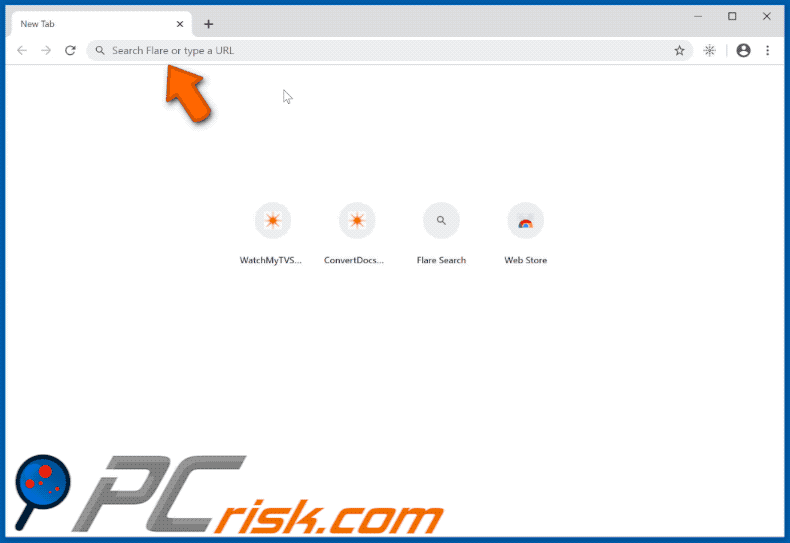
Instant automatic malware removal: Manual threat removal might be a lengthy and complicated process that requires advanced computer skills. Combo Cleaner is a professional automatic malware removal tool that is recommended to get rid of malware. Download it by clicking the button below:
▼ DOWNLOAD Combo Cleaner By downloading any software listed on this website you agree to our Privacy Policy and Terms of Use. To use full-featured product, you have to purchase a license for Combo Cleaner. 7 days free trial available. Combo Cleaner is owned and operated by Rcs Lt, the parent company of PCRisk.com read more.
Quick menu:
- What is google.com?
- STEP 1. Uninstall unwanted applications using Control Panel.
- STEP 2. Remove google.com redirect from Internet Explorer.
- STEP 3. Remove google.com browser hijacker from Google Chrome.
- STEP 4. Remove google.com homepage and default search engine from Mozilla Firefox.
- STEP 5. Remove google.com redirect from Safari.
- STEP 6. Remove rogue plug-ins from Microsoft Edge.
Google.com redirect removal:
Windows 11 users:

Right-click on the Start icon, select Apps and Features . In the opened window search for the application you want to uninstall, after locating it, click on the three vertical dots and select Uninstall .
Windows 10 users:

Right-click in the lower left corner of the screen, in the Quick Access Menu select Control Panel . In the opened window choose Programs and Features .
Windows 7 users:

Click Start (Windows Logo at the bottom left corner of your desktop), choose Control Panel . Locate Programs and click Uninstall a program .
macOS (OSX) users:
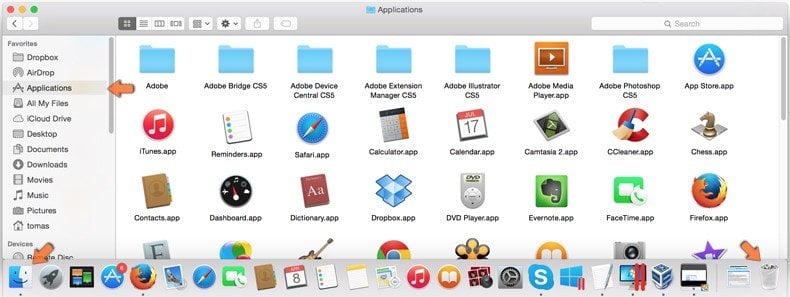
Click Finder , in the opened screen select Applications . Drag the app from the Applications folder to the Trash (located in your Dock), then right click the Trash icon and select Empty Trash .
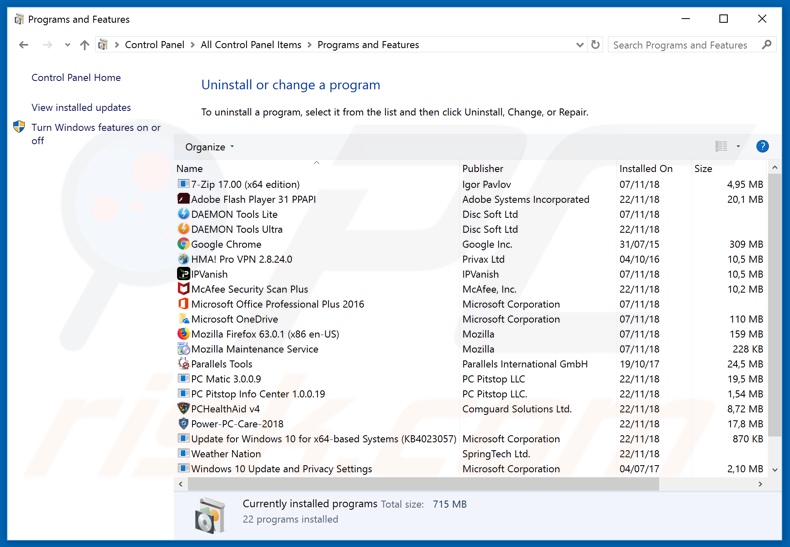
In the uninstall programs window: look for any recently installed suspicious applications, select these entries and click "Uninstall" or "Remove".
After uninstalling the potentially unwanted applications (which cause browser redirects to the google.com website), scan your computer for any remaining unwanted components. To scan your computer, use recommended malware removal software.
google.com redirect removal from Internet browsers:
Video showing how to remove browser redirects:
 Remove malicious add-ons from Internet Explorer:
Remove malicious add-ons from Internet Explorer:
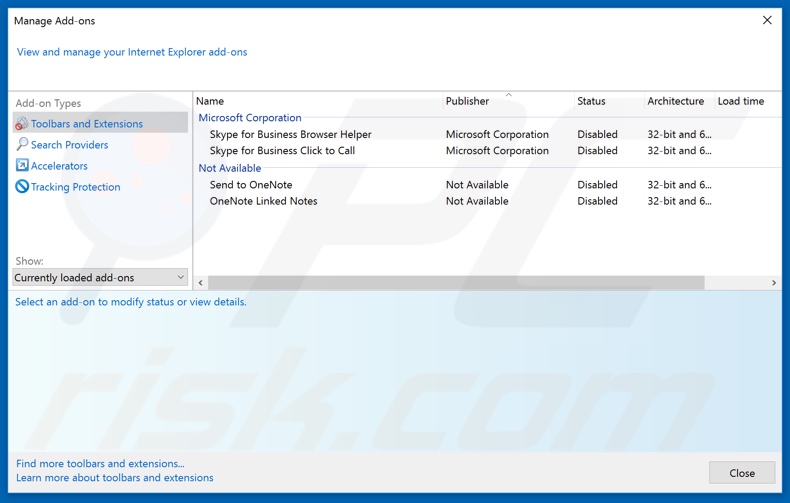
Click the "gear" icon ![]() (at the top right corner of Internet Explorer), select "Manage Add-ons". Look for any recently installed suspicious extensions, select these entries and click "Remove".
(at the top right corner of Internet Explorer), select "Manage Add-ons". Look for any recently installed suspicious extensions, select these entries and click "Remove".
Change your homepage:
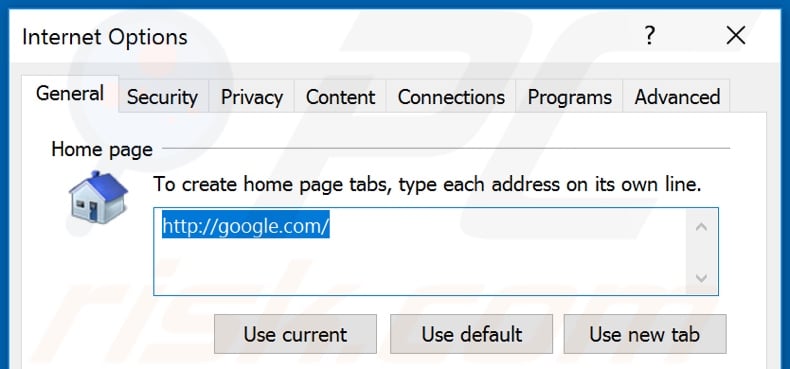
Click the "gear" icon ![]() (at the top right corner of Internet Explorer), select "Internet Options", in the opened window remove hxxp://google.com and enter your preferred domain, which will open each time you launch Internet Explorer. You can also enter about: blank to open a blank page when you start Internet Explorer.
(at the top right corner of Internet Explorer), select "Internet Options", in the opened window remove hxxp://google.com and enter your preferred domain, which will open each time you launch Internet Explorer. You can also enter about: blank to open a blank page when you start Internet Explorer.
Change your default search engine:
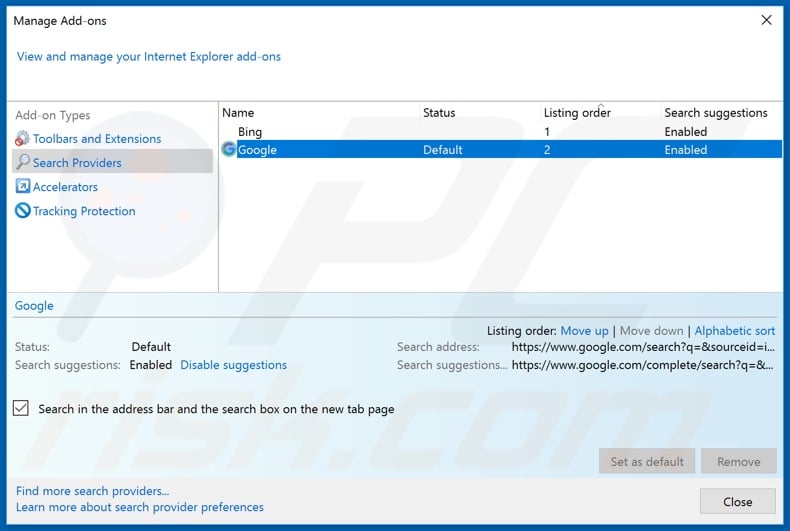
Click the "gear" icon ![]() (at the top right corner of Internet Explorer), select "Manage Add-ons". In the opened window, select "Search Providers", set "Google", "Bing", or any other preferred search engine as your default and then remove "google.com".
(at the top right corner of Internet Explorer), select "Manage Add-ons". In the opened window, select "Search Providers", set "Google", "Bing", or any other preferred search engine as your default and then remove "google.com".
Optional method:
If you continue to have problems with removal of the google.com browser hijacker, reset your Internet Explorer settings to default.
Windows XP users: Click Start , click Run , in the opened window type inetcpl.cpl In the opened window click the Advanced tab, then click Reset .

Windows Vista and Windows 7 users: Click the Windows logo, in the start search box type inetcpl.cpl and click enter. In the opened window click the Advanced tab, then click Reset .

Windows 8 users: Open Internet Explorer and click the gear icon. Select Internet Options .

In the opened window, select the Advanced tab.

Click the Reset button.

Confirm that you wish to reset Internet Explorer settings to default by clicking the Reset button.

 Remove malicious extensions from Google Chrome:
Remove malicious extensions from Google Chrome:
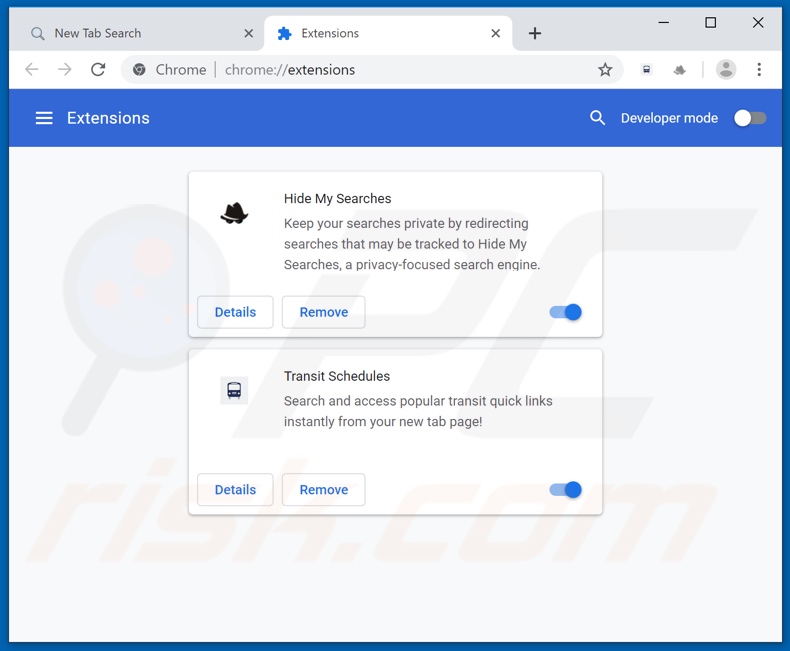
Click the Chrome menu icon![]() (at the top right corner of Google Chrome), select "More tools" and click "Extensions". Locate all recently-installed suspicious browser add-ons and remove them.
(at the top right corner of Google Chrome), select "More tools" and click "Extensions". Locate all recently-installed suspicious browser add-ons and remove them.
Change your homepage:
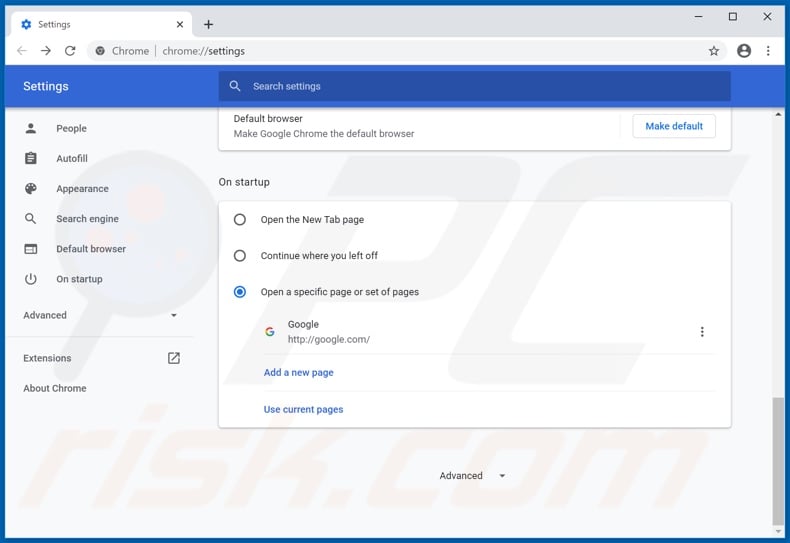
Click the Chrome menu icon![]() (at the top right corner of Google Chrome), select "Settings". In the "On startup" section, look for a browser hijacker URL (hxxp://www.google.com) below the "Open a specific or set of pages" option. If present click on the three vertical dots icon and select "Remove".
(at the top right corner of Google Chrome), select "Settings". In the "On startup" section, look for a browser hijacker URL (hxxp://www.google.com) below the "Open a specific or set of pages" option. If present click on the three vertical dots icon and select "Remove".
Change your default search engine:
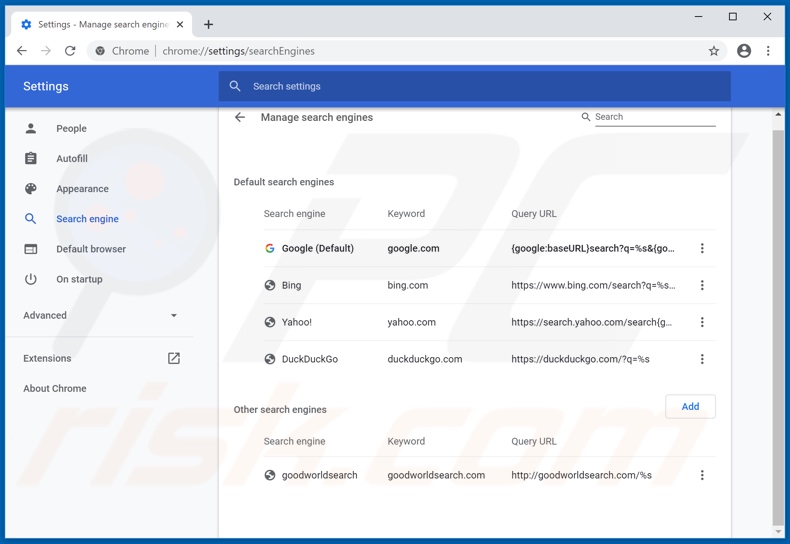
To change your default search engine in Google Chrome: Click the Chrome menu icon![]() (at the top right corner of Google Chrome), select "Settings", in the "Search engine" section, click "Manage search engines...", in the opened list look for "google.com" when located click the three vertical dots near this URL and select "Remove from list".
(at the top right corner of Google Chrome), select "Settings", in the "Search engine" section, click "Manage search engines...", in the opened list look for "google.com" when located click the three vertical dots near this URL and select "Remove from list".
Optional method:
If you continue to have problems with removal of the google.com browser hijacker, reset your Google Chrome browser settings. Click the Chrome menu icon ![]() (at the top right corner of Google Chrome) and select Settings . Scroll down to the bottom of the screen. Click the Advanced… link.
(at the top right corner of Google Chrome) and select Settings . Scroll down to the bottom of the screen. Click the Advanced… link.

After scrolling to the bottom of the screen, click the Reset (Restore settings to their original defaults) button.

In the opened window, confirm that you wish to reset Google Chrome settings to default by clicking the Reset button.

 Remove malicious plugins from Mozilla Firefox:
Remove malicious plugins from Mozilla Firefox:

Click the Firefox menu ![]() (at the top right corner of the main window), select "Add-ons". Click on "Extensions" and remove all recently installed browser plug-ins.
(at the top right corner of the main window), select "Add-ons". Click on "Extensions" and remove all recently installed browser plug-ins.
Change your homepage:
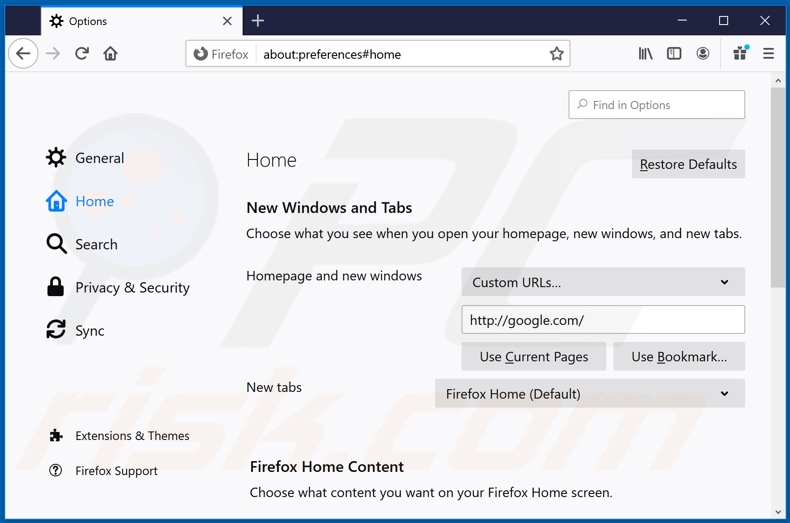
To reset your homepage, click the Firefox menu ![]() (at the top right corner of the main window), then select "Options", in the opened window remove hxxp://google.com and enter your preferred domain, which will open each time you start Mozilla Firefox.
(at the top right corner of the main window), then select "Options", in the opened window remove hxxp://google.com and enter your preferred domain, which will open each time you start Mozilla Firefox.
Change your default search engine:
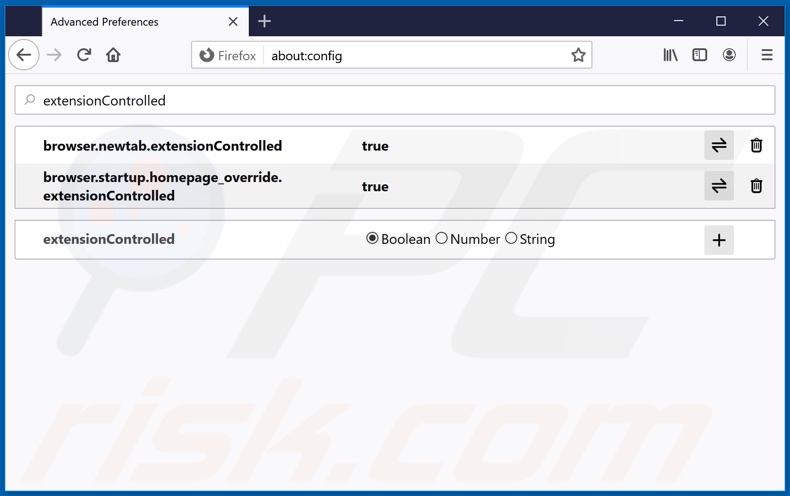
In the URL address bar, type about:config and press Enter.
Click "I'll be careful, I promise!".
In the search filter at the top, type: "extensionControlled"
Set both results to "false" by either double-clicking each entry or clicking the ![]() button.
button.
Optional method:
Computer users who have problems with google.com browser hijacker removal can reset their Mozilla Firefox settings.
Open Mozilla Firefox, at the top right corner of the main window, click the Firefox menu , ![]() in the opened menu, click Help.
in the opened menu, click Help.

Select Troubleshooting Information .

In the opened window, click the Refresh Firefox button.

In the opened window, confirm that you wish to reset Mozilla Firefox settings to default by clicking the Refresh Firefox button.

 Remove malicious extensions from Safari:
Remove malicious extensions from Safari:

Make sure your Safari browser is active and click Safari menu, then select Preferences...

In the preferences window select the Extensions tab. Look for any recently installed suspicious extensions and uninstall them.

In the preferences window select General tab and make sure that your homepage is set to a preferred URL, if its altered by a browser hijacker - change it.

In the preferences window select Search tab and make sure that your preferred Internet search engine is selected.
Optional method:
Make sure your Safari browser is active and click on Safari menu. From the drop down menu select Clear History and Website Data...

In the opened window select all history and click the Clear History button.

 Remove malicious extensions from Microsoft Edge:
Remove malicious extensions from Microsoft Edge:

Click the Edge menu icon![]() (at the top right corner of Microsoft Edge), select "Extensions". Locate any recently-installed suspicious browser add-ons, and remove them.
(at the top right corner of Microsoft Edge), select "Extensions". Locate any recently-installed suspicious browser add-ons, and remove them.
Change your homepage and new tab settings:

Click the Edge menu icon![]() (at the top right corner of Microsoft Edge), select "Settings". In the "On startup" section look for the name of the browser hijacker and click "Disable".
(at the top right corner of Microsoft Edge), select "Settings". In the "On startup" section look for the name of the browser hijacker and click "Disable".
Change your default Internet search engine:
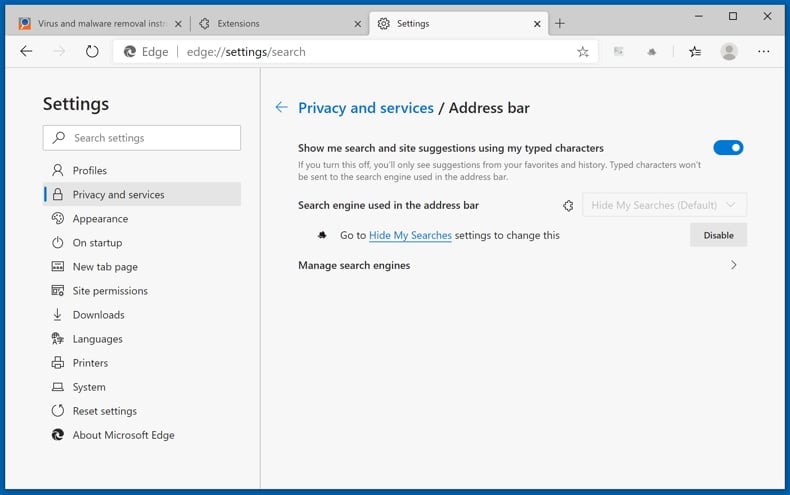
To change your default search engine in Microsoft Edge: Click the Edge menu icon![]() (at the top right corner of Microsoft Edge), select "Privacy and services", scroll to bottom of the page and select "Address bar". In the "Search engines used in address bar" section look for the name of the unwanted Internet search engine, when located click the "Disable" button near it. Alternatively you can click on "Manage search engines", in the opened menu look for unwanted Internet search engine. Click on the puzzle icon
(at the top right corner of Microsoft Edge), select "Privacy and services", scroll to bottom of the page and select "Address bar". In the "Search engines used in address bar" section look for the name of the unwanted Internet search engine, when located click the "Disable" button near it. Alternatively you can click on "Manage search engines", in the opened menu look for unwanted Internet search engine. Click on the puzzle icon ![]() near it and select "Disable".
near it and select "Disable".
Optional method:
If you continue to have problems with removal of the google.com browser hijacker, reset your Microsoft Edge browser settings. Click the Edge menu icon ![]() (at the top right corner of Microsoft Edge) and select Settings .
(at the top right corner of Microsoft Edge) and select Settings .

In the opened settings menu select Reset settings .

Select Restore settings to their default values . In the opened window, confirm that you wish to reset Microsoft Edge settings to default by clicking the Reset button.

- If this did not help, follow these alternative instructions explaining how to reset the Microsoft Edge browser.
Summary:
 A browser hijacker is a type of adware infection that modifies Internet browser settings by assigning the homepage and default Internet search engine settings to some other (unwanted) website URL. Commonly, this type of adware infiltrates operating systems through free software downloads. If your download is managed by a download client, ensure that you decline offers to install advertised toolbars or applications that seek to change your homepage and default Internet search engine settings.
A browser hijacker is a type of adware infection that modifies Internet browser settings by assigning the homepage and default Internet search engine settings to some other (unwanted) website URL. Commonly, this type of adware infiltrates operating systems through free software downloads. If your download is managed by a download client, ensure that you decline offers to install advertised toolbars or applications that seek to change your homepage and default Internet search engine settings.
Post a comment:
If you have additional information on google.com browser hijacker or it's removal please share your knowledge in the comments section below.
About the author:

Tomas Meskauskas - expert security researcher, professional malware analyst.
I am passionate about computer security and technology. I have an experience of over 10 years working in various companies related to computer technical issue solving and Internet security. I have been working as an author and editor for pcrisk.com since 2010. Follow me on Twitter and LinkedIn to stay informed about the latest online security threats. Contact Tomas Meskauskas.
PCrisk security portal is brought by a company RCS LT. Joined forces of security researchers help educate computer users about the latest online security threats. More information about the company RCS LT.
Our malware removal guides are free. However, if you want to support us you can send us a donation.
How To Get Rid Of Ads On Google
Source: https://www.pcrisk.com/removal-guides/4251-remove-google-redirect-virus
Posted by: katoprieture.blogspot.com

0 Response to "How To Get Rid Of Ads On Google"
Post a Comment